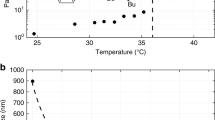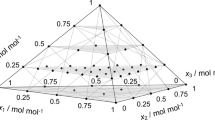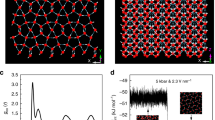Abstract
When a simple alcohol such as methanol or ethanol is mixed with water1,2, the entropy of the system increases far less than expected for an ideal solution of randomly mixed molecules3. This well-known effect has been attributed to hydrophobic headgroups creating ice-like or clathrate-like structures in the surrounding water4, although experimental support for this hypothesis is scarce5,6,7. In fact, an increasing amount of experimental and theoretical work suggests that the hydrophobic headgroups of alcohol molecules in aqueous solution cluster together2,8,9,10. However, a consistent description of the details of this self-association is lacking11,12,13. Here we use neutron diffraction with isotope substitution to probe the molecular-scale structure of a concentrated alcohol–water mixture (7:3 molar ratio). Our data indicate that most of the water molecules exist as small hydrogen-bonded strings and clusters in a ‘fluid’ of close-packed methyl groups, with water clusters bridging neighbouring methanol hydroxyl groups through hydrogen bonding. This behaviour suggests that the anomalous thermodynamics of water–alcohol systems arises from incomplete mixing at the molecular level and from retention of remnants of the three-dimensional hydrogen-bonded network structure of bulk water.
This is a preview of subscription content, access via your institution
Access options
Subscribe to this journal
Receive 51 print issues and online access
$199.00 per year
only $3.90 per issue
Buy this article
- Purchase on Springer Link
- Instant access to full article PDF
Prices may be subject to local taxes which are calculated during checkout




Similar content being viewed by others
References
Franks, F. & Ives, D. J. G. The structural properties of alcohol–water mixtures. Q. Rev. 20, 1–45 (1966)
Franks, F. & Desnoyers, J. E. in Water Science Reviews Vol. 1 (ed. Franks, F.) 171–232 (Cambridge Univ. Press, 1985)
Murrell, J. N. & Jenkins, A. D. Properties of Liquids and Solutions 2nd edn 102–106 (Wiley, Chichester, 1994)
Frank, H. S. & Evans, M. W. Free volume and entropy in condensed systems. III. Entropy in binary liquid mixtures; partial molal entropy in dilute solutions; structure and thermodynamics in aqueous electrolytes. J. Chem. Phys. 13, 507–532 (1945)
Soper, A. K. & Finney, J. L. Hydration of methanol in aqueous solution. Phys. Rev. Lett. 71, 4346–4349 (1993)
Turner, J. & Soper, A. K. The effect of apolar solutes on water structure: alcohols and tetraalkylammonium ions. J. Chem. Phys. 101, 6116–6125 (1994)
Bowron, D. T., Soper, A. K. & Finney, J. L. Temperature dependence of the structure of a 0.06 mole fraction tertiary butanol–water solution. J. Chem. Phys. 114, 6203–6219 (2001)
Tsai, J., Gerstein, M. & Levitt, M. Keeping the shape but changing the charges: A simulation study of urea and its iso-steric analogs. J. Chem. Phys. 104, 9417–9430 (1996)
Dixit, S., Poon, W. C. K. & Crain, J. Hydration of methanol in aqueous solutions: a Raman spectroscopic study. J. Phys. Condens. Matter 12, L323–L328 (1999)
Wakisaka, A., Komatsu, S. & Usui, Y. Solute–solvent and solvent–solvent interactions evaluated through clusters isolated from solutions: preferential solvation in water–alcohol mixtures. J. Mol. Liq. 90, 175–184 (2001)
D'Angelo, M., Onori, G. & Santucci, A. Self-association of monohydric alcohols in water: compressibility and infrared absorption measurements. J. Chem. Phys. 100, 3107–3113 (1994)
Egashira, K. & Nishi, N. Low-frequency Raman spectroscopy of ethanol–water binary solution: evidence for self-association of solute and solvent molecules. J. Phys. Chem. B 102, 4054–4057 (1998)
Yoshida, K. & Yamaguchi, T. Low temperature Raman spectroscopy of aqueous solutions of aliphatic alcohols. Z. Naturforsch. A 56, 529–536 (2001)
Finney, J. L., Bowron, D. T. & Soper, A. K. The structure of aqueous solutions of tertiary butanol. J. Phys. Condens. Matter 12, A123–A128 (2000)
Ferrario, M., Haughney, M., McDonald, I. R. & Klein, M. L. Molecular dynamics simulation of aqueous mixtures: methanol, acetone and ammonia. J. Chem. Phys. 93, 5156–5166 (1990)
Palinkas, G., Hawlicka, E. & Heinzinger, K. Molecular-dynamics simulations of water–methanol mixtures. Chem. Phys. 158, 65–76 (1991)
Tanaka, H. & Gubbins, K. Structure and thermodynamic properties of water–methanol mixtures. J. Chem. Phys. 97, 2626–2634 (1992)
Laaksonen, A., Kusalik, P. G. & Svishchev, I. M. Three-dimensional structure in water–methanol mixtures. J. Phys. Chem. A 101, 5910–5918 (1997)
Yamaguchi, T., Hidaka, K. & Soper, A. K. The structure of liquid methanol revisited: a neutron diffraction experiment at - 80°C and +25°C. Mol. Phys. 96, 1159–1168 (1999); Erratum 97, 603–605 (1999)
Soper, A. K. The radial distribution functions of water and ice from 220 K to 673 K and at pressures up to 400 MPa. Chem. Phys. 258, 121–137 (2000)
Murthy, S. S. N. Detailed study of ice clathrate relaxation: Evidence for the existence of clathrate structures in some water–alcohol mixtures. J. Phys. Chem. A 103, 7927–7937 (1999)
Soper, A. K. & Luzar, A. A neutron diffraction study of dimethyl sulphoxide-water mixtures. J. Chem. Phys. 97, 1320–1331 (1992)
Soper, A. K. Empirical potential Monte Carlo simulation of fluid structure. Chem. Phys. 202, 295–306 (1996)
Bowron, D. T., Finney, J. L. & Soper, A. K. A structural investigation of solute–solute interactions in aqueous solutions of tertiary butanol. J. Phys. Chem. B 102, 3551–3563 (1998)
Soper, A. K. Tests of the empirical potential structure refinement method and a new method of application to neutron diffraction data on water. Mol. Phys. 99, 1503–1516 (2001)
Acknowledgements
S. D. is supported by the Edinburgh Chalmers Scholarship and the ORS award. Funding from the EPSRC Liquid Network and help from D. Bowron at an early stage of the experiments are gratefully acknowledged.
Author information
Authors and Affiliations
Corresponding author
Ethics declarations
Competing interests
The authors declare that they have no competing financial interests
Rights and permissions
About this article
Cite this article
Dixit, S., Crain, J., Poon, W. et al. Molecular segregation observed in a concentrated alcohol–water solution. Nature 416, 829–832 (2002). https://doi.org/10.1038/416829a
Received:
Accepted:
Issue Date:
DOI: https://doi.org/10.1038/416829a
This article is cited by
-
Molecular Dynamics Simulation Studies on the Micromorphology and Proton Transport of Nafion/Ti3C2Tx Composite Membrane
Chinese Journal of Polymer Science (2024)
-
Solvent-pair surfactants enabled assembly of clusters and copolymers towards programmed mesoporous metal oxides
Nature Communications (2023)
-
Lifetime distribution of clusters in binary mixtures involving hydrogen bonding liquids
Scientific Reports (2022)
-
The impact of H/D exchange on the thermal and structural properties as well as high-pressure relaxation dynamics of melatonin
Scientific Reports (2022)
-
The Journey of 1-Keto-1,2,3,4-Tetrahydrocarbazole Based Fluorophores: From Inception to Implementation
Journal of Fluorescence (2022)
Comments
By submitting a comment you agree to abide by our Terms and Community Guidelines. If you find something abusive or that does not comply with our terms or guidelines please flag it as inappropriate.



